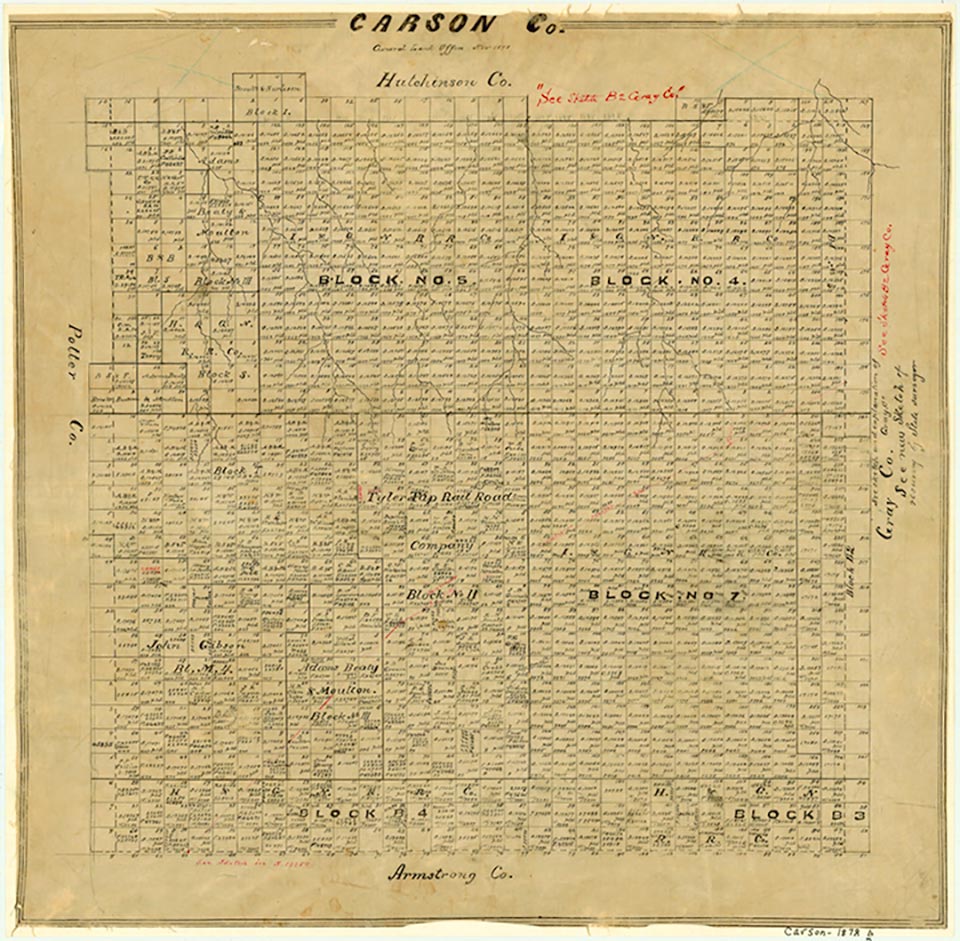White Deer
White Deer, on U.S. Highway 60 in east central Carson County, is named for nearby White Deer Creek, where, according to local legend, an Indian saw an albino deer drinking. The town's history began in 1882 when the British-owned Francklyn Land and Cattle Company, later reorganized as White Deer Lands, occupied the area and began stocking it with cattle. George Tyng, general manager of the property, built headquarters for the White Deer or Diamond F Ranch at the site in 1887. The county's first water well was drilled nearby. In 1886 and 1887 the Purcell Company, made up of Kansas capitalists, purchased land in the vicinity as a right-of-way for the Southern Kansas Railway of Texas, which arrived in 1887. Because of the well the railroad chose the site for a depot and built it in 1888. Initially named Paton (after John Paton) and then Whig, the town was renamed White Deer in January 1889. In December 1888 the first general store and a lumberyard were established, and a post office was opened. By 1891 a school district had been established. In the 1890s White Deer Lands, the trust of British bondholders, began leasing its holdings to ranchers, and during the following decade, the company started subdividing and selling its holdings for small farms and ranches. Soon settlers arrived in large numbers. The town was originally a half mile east on the railroad line, but it moved in 1908. White Deer rapidly grew as a supply town for settlers and by 1910 had a population estimated at fifty. Local organizations like the White Deer Literary Society brought culture to the community. White Deer's ethnic diversity was heightened in 1909, when Henry Czerner and Ben Urbanczyk established a community of Polish farmers from Central Texas at the northeast edge of town. These colonists erected the Sacred Heart Catholic Church in 1913. A Methodist church had been organized in 1911, when a Presbyterian church was already functioning. The First State Bank (later the First National Bank) of White Deer opened in 1916.
The discovery of oil and gas in Carson County in 1919 contributed to the growth of White Deer. The city was incorporated in 1921, and by 1925 White Deer had a population estimated at 200. The peak of the oil boom at Skellytown, in the White Deer school district, occurred in 1926, and in the same year White Deer businessmen established a Board of City Development. The Skellytown boom greatly increased the population in White Deer, which peaked at 3,000 in 1928 and then began to decline. White Deer suffered a disastrous fire in 1931, and tornadoes struck in 1947 and 1951. By 1954 the town's population had shrunk to 629. In the late 1950s White Deer began a period of moderate growth, serving as a shipping point for grain and cattle produced in the area. The 1980 White Deer population was 1,210, and in 1984 the town had twenty-one businesses, five churches, two schools, and a weekly newspaper, the White Deer News. A statue of a white deer stands on a concrete pedestal in the middle of the town's main intersection. The population was 1,125 in 1990 and 1,060 in 2000.
H. Allen Anderson | © TSHA

Adapted from the official Handbook of Texas, a state encyclopedia developed by Texas State Historical Association (TSHA). It is an authoritative source of trusted historical records.

- ✅ Adoption Status:
- This place is available for adoption! Available for adoption!
- Adopted by:
- Your name goes here
- Dedication Message:
- Your message goes here
Belongs to
White Deer is part of or belongs to the following places:
Currently Exists
Yes
Place type
White Deer is classified as a Town
Associated Names
- (Paton)
- (Whig)
Location
Latitude: 35.43319280Longitude: -101.17507000
Has Post Office
Yes
Is Incorporated
Yes
Population Count, 2021 View more »
904

